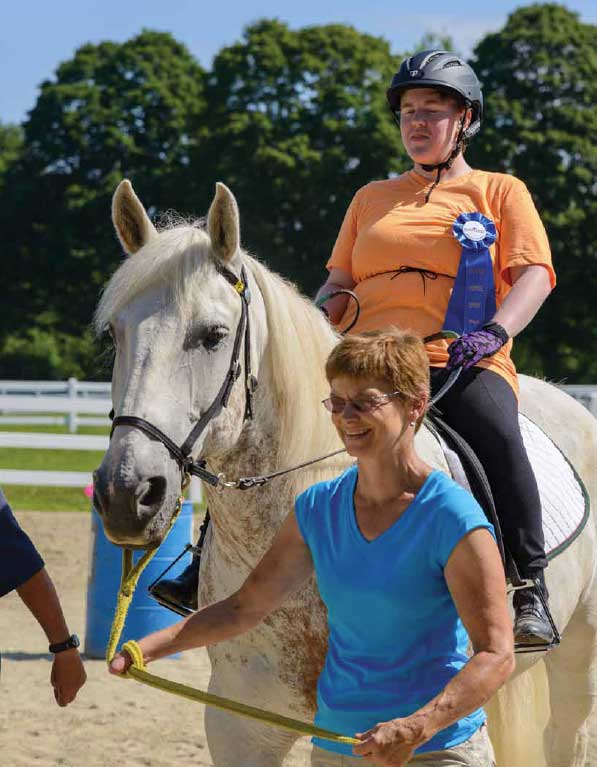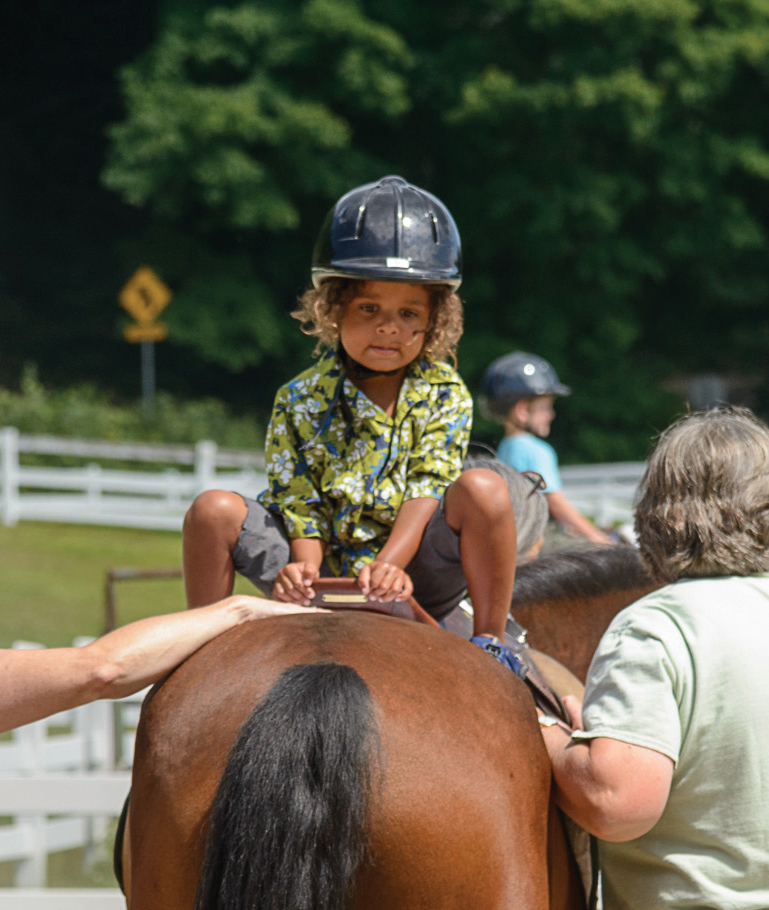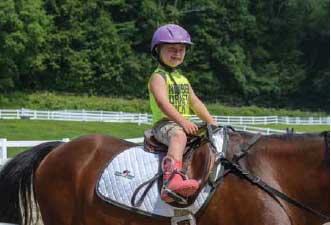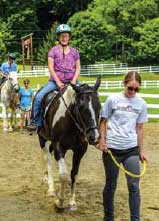By Nancy Boardman
Photography By Hubert Schriebl
“There is something about the inside of a horse that is good for the inside of a man,” declared Winston Churchill. And nowhere is that more evident than in the riding ring or a paddock at Winchester Stables, just north of the village of Newfane. There, children and adults who face physical, emotional and behavioral challenges find the opportunity to shine, laugh, learn and get stronger, all in ways that probably seemed unlikely, if not impossible, not so long ago.
Jahlani is an adorable almost-five-year-old who lives in Putney with his mother, Melanie White. One of the youngest students in the Southern Vermont Therapeutic Riding Center program, he’s been riding at Winchester Stables once a week for more than a year now. In the beginning, reports his mom, Jahlani rarely spoke, which was not very different from his behavior at home or anywhere else. Yet at Winchester, his SVTRC instructors gently, consistently encouraged him to say out loud “walk on,” the command the horse knows means to move forward. But the most Jahlani would do was tap his mount’s shoulder, the nonverbal command to move on. Then one day, to the surprise and delight of everyone around him, he said, with the accompanying tap, “Walk on.” As he and the horse did, a communication barrier that once had seemed insurmountable came crashing down.
Says Melanie, “This program has made a huge impact on his life. He loves the horses, and he’s meeting the goals the program has set for him. He counts while brushing the horse after the lesson, and his balance and strength are much better since he started riding. Plus, I know I can use the same techniques at home. If we’re out walking in the woods and he gets distracted or starts to wander, I can say ‘Walk on’ and he knows exactly what I want him to do.”
Transformation
Jahlani’s transformation is just one of the many that occur almost daily under the rafters and between the hay bales at the Southern Vermont Therapeutic Riding Center. People of all ages with a variety of special needs come to the stables to take part in one of three programs offered in 12-week-long sessions throughout the year. Students can choose to participate in therapeutic riding, which is geared to anyone with physical, cognitive or emotional problems. Some riders opt to learn the basics of horse care and safety around horses, while others take the vocational path, developing career skills in horsemanship, equine behavior and horse care. By far the most popular of the three is therapeutic riding. It’s the program that is most challenging to the SVTRC staff, volunteers, riders and even the horses themselves, but at the same time, it’s the one that provides the most rewards to them all, whether they have two legs or four.
The center began in 2010, when the owner of Winchester, aware of the benefits of hippotherapy, reached out to find someone who might like to begin a therapeutic riding program that would be housed at the stables. Enthusiastically rising to the challenge was Lorna Young, who had returned to her home state of New Hampshire after years of moving with her family to whatever part of the country her husband’s consulting business took them. The hourplus commute to Newfane didn’t faze her in the least; “I was delighted to have the chance to start a program in Southern Vermont, which didn’t have one at the time.”
Therapeutic Riding is the most challenging program to the SVTRC staff, volunteers, riders and even the horses, but at the same time, it’s the one that provides the most rewards.
The benefits of having horses provide therapy for humans have long been recognized in Europe, but the first therapeutic riding program in this country didn’t began until the late 1960s, when the Cheff Therapeutic Riding Center opened in Michigan. A rider, 4-H’er and horse-lover from birth, Lorna learned the teaching basics at Cheff, and went on to become an accredited instructor back there and at similar programs around the country—including the High Hopes program in Old Lyme, CT—and founded Helping Horse Therapeutic Riding in Raleigh, NC. Her days at Winchester now include training others to be certified instructors.
Lorna well knows how horses can help people. “I was born missing some fingers on my right hand,” she says. “But I could always ride, so horses provided me with a sport, a way to be the same as other kids.”
The Program is Huge
SVTRC began with just one student and one horse. Now, thanks to Lorna’s outreach skills and the growing recognition of its worth, the program is huge. A host of area schools and institutions take part, including Leland & Gray Union Middle and High School in Townshend, Kindle Farm School in Newfane, Brattleboro’s INSPIRE School, Landmark College in Putney, the Brattleboro Retreat and Winhall Elementary, along with the Wounded Warriors Project, the Department of Veterans Affairs and VT Health Care and Rehabilitation Services. The program also partners with Big Brothers Big Sisters of Brattleboro to provide riding time for groups of “Littles” while the “Bigs” volunteer as side-walkers and helpers. Of the 50 or so riders who participate in SVTRC each year, about two-thirds are young adults and children, some as young as four years old.
The program took a major step forward in 2011, when it became accredited by the Professional Association of Therapeutic Horsemanship. (Many stables and riding centers in Vermont now offer therapeutic riding programs, but only a few are PATH-accredited, and SVRTC is the only one in the southern part of the state.)
The center leases space from Winchester Stables, and its five horses have either been donated or are on loan to the program. These are truly gentle giants; Thor, Quinn, Jackie, Chaps and Duke are imposing in stature, but their temperaments are mellow and patient. “The horses are an enormous part of the therapeutic process,” says Lorna. “They are our partners. We don’t ‘use’ them; we workwith them and through them. Along with the instructors, the horses are the agents of the change that we see in the students.
Just to be way up high on one of the horses is exhilarating, if initially scary. For a child who may have trouble walking, or cannot stay focused, or has difficulty communicating with people, or who lacks self-confidence, or who isn’t good at sports, the mere fact of being safely perched on that broad back can betransformative.
Volunteers
Dave Larsen and his wife Kathy are among the program’s many volunteers, helping riders on and off their horse, side-walking with the horse and rider as they move around the ring or on a trail, and just offering encouragement and tips along the way. Says Dave, “Instead of working with a large balance ball or some other piece of inanimate equipment,the riders are dealing with another living being, one that has intelligence and feelings. They can respond to that.”
Knowing that such a big, powerful animal is so immediately responsive gives a rider a feeling of control, greater self awareness, and a sense of accomplishment.
And they soon realize that the horse responds to them. Lorna will say to a child who may be distracted by something going on elsewhere in the ring, “Thor is turning because he feels your body turning. Stay focused.” The child has probably heard that command before—often, in fact, and likely with a sense of impatience— but when he hears it in relation to the task at hand, he quickly returns his attention to the horse. Knowing that such a big, powerful animal is so immediately responsive gives a rider a feeling of control, greater self-awareness, and a sense of accomplishment. Says Lorna, “The horse is in the moment; it’s not thinking about the past or worrying about the future. It requires the same of the rider. And that really helps the student focus.”
Developing Skills
Indeed, autistic children, those with attention-deficit challenges and people suffering from Post Traumatic Stress Disorder respond remarkably well to horse-centered therapy. Lorna and the program’s three other certified instructors not only impart riding skills, but also incorporate all sorts of educational components into the lesson. A child may be asked to count the strokes as he curries his mount, or identify the colors of flags as she rides around the ring, or play Red Light Green Light. “Educators are recognizing potential problem areas in kids earlier than ever now, which gets them appropriate therapy sooner than before. The schools that send students here let us know what sort of educational or developmental things we need to work on. We set goals for the rides, and later the lessons are assessed and evaluated as to whether or not they were effective for the child. We know that riding helps kids learn in important ways that aren’t traditional, and we are working as educators to show how incredibly effective it can be. We see that every day in the riding ring, but it’s progress that may not be evident in a classroom.”
Support Needed
As anyone who owns one knows, horses are not an inexpensive proposition. It costs SVTRC roughly $3,000 per month to board the five horses, which doesn’t include shoeing and medical treatment, anticipated or otherwise. Then, too, while much of the work is done by volunteers, there are several salaries that must be covered, such as those of the instructors. The fees paid by private riders and by the schools who send pupils there help defray some of those expenses, but yearly outlays are still enormous. Lorna estimates that the cost of an hour’s lesson is $66, with riders paying $40. “Even though there are some riders on full scholarships, basically all the riders are on scholarship, in the sense that every session is being subsidized to some extent.”
As a result, like non-profits everywhere, SVTRC has found other ways to raise money, some traditional (BBQs, silent auctions, a fall bulb sale, community-sponsored fundraisers), others that are creatively equinecentered, such as the Barn Buddies program. Specific amounts will cover one month’s boarding…or hay and grain for a month…or the cost of inoculations, shoeing or worming. Barn Buddies are awarded a ribbon color keyed to the amount of their gift, and receive a big welcome at the stables if they want to spend time grooming, hugging or just hanging out with “their” horse.
Nowhere are the students’ feelings of accomplishment and joy more evident than at the annual horse show, held each August at the stables. Regardless of the type or extent of their challenges, students can show off their progress, even prowess, and every rider wins a ribbon in his or her class. The 2014 horse show was followed by a silent auction (“Saddle Up for Success”) and barbeque, another way the SVTRC raises not just funds, but also friends, for the program.
Meredith Kenyon of West Townshend is involved in the center to an unusual extent; she is a rider, a volunteer for the horse show, and also serves on the Board of Directors. Meredith has MS, which affects her gait. She’s found that riding—which she does every week, both on trails and in the ring—has been wonderful therapy. “I’m usually very aware of what my body can’t do. When I ride, I’m delighted to see what it can do!” Her usual mount is Jackie, a sweet paint mare. Asked why children seem intrepid about getting on a horse, Meredith says, “The gentle nature of the horses in the program helps so much to overcome their fears. Even though they’re up so high, they feel in control. They sense a mastery they might not feel otherwise in their lives.” Of her own progress since joining the program in 2013, she adds, “I still need help with the tack, and getting on the horse, but I’ve become a much more independent rider, and a lot more confident.”
Sammi Pelton is an 18-year-old with Down Syndrome who began riding at Winchester the first season Lorna opened the program. Her mother, Patricia, a teacher at Leland & Gray, where Sammi is a student, reports that the program has benefited Sammi in numerous ways. “Not only has it boosted her confidence and improved her balance and upper-body strength, it’s helped her develop her skills to cope. She has transitioned through many horses, which has made it easier for her to handle transitions in relationships, as well. She lost her best friend to cancer just a year ago, but knows she will be OK because she has her horse, Quinn.” In fact, Patricia continues, “Sammi is a very different kiddo when she gets off the horse. She’s developed a true passion for horses, and looks toward this as a hobby and possibly a career.”
The Healing Power of Horses
Probably every person who is involved with the SVTRC—Lorna, the instructors and volunteers, the riders, their parents and their teachers—can attest to the power of the program. A heightened sense of empathy with animals and other people…a new-found feeling of emotional independence, physical strength and even vocational possibility, the discovery that there is a sport in which they can excel: all offer proof positive on a daily basis of the healing power of the human-horse partnership. Put one way, by a young man who is an enthusiastic rider in the SVTRC family, “Horses keep out the noise and the chaos of the world.” Or, as Lorna says, “In so many ways, riding allows people to go places they’ve never gone before.” ◊
Nancy Boardman is a senior writer for Stratton Magazine.





